Waldburg Castle
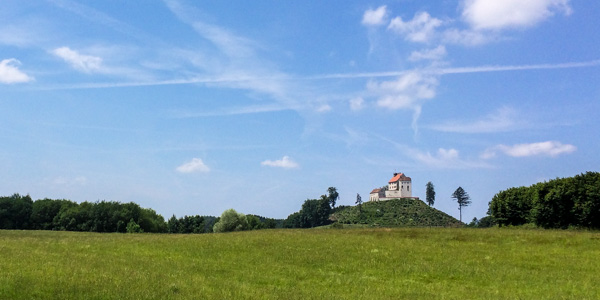
Waldburg Castle sits on the highest point in Upper Swabia.
Waldburg Castle is one of the homiest castles you can tour, and comes with a surprising American connection
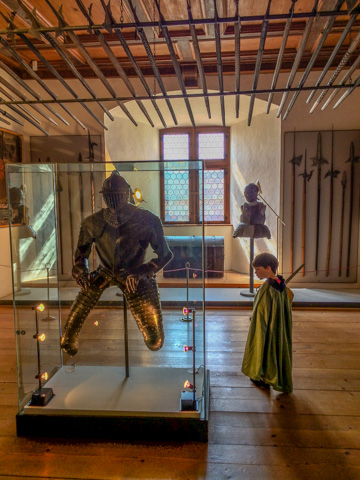
Arms and armor on display at Waldburg Castle (where, yes, the kids get to dress up in medieval costume to tour it).
The sturdy little 12th-century Castle Waldburg is surrounded by a lovely network of forest and farmland trails in the Upper Swabian countryside.
The restored rooms at Waldburg Castle contain a nice collection of arms and armor (some of which they let visitors handle on tours), and—as of March, 2014—reproductions of the Holy Roman Imperial regalia and crown jewels that, in the 13th century, Eberhard von Tanne-Waldburg safeguarded here for Emperor Frederick II (these, visitors cannot touch).
The Waldburg is also a very homey, welcoming castle.
Throughout the summer it sponsors many concerts, movie nights, beer gardens, and medieval markets for local craftspeople in the courtyard.
There are also family days with kid-friendly activities and tours. (Shoot a crossbow! Make medieval food in the giant kitchen oven! Tour in costume! My six-year-old loved it.)
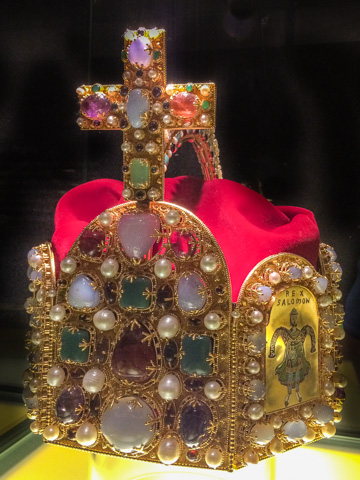
A replica of the Holy Roman Emperor's crown on display at Waldburg Castle (where the original was once kept in the castle Treasury).
Castle Waldburg also has a quirky American connection.
The little glacial drumlin atop which the Waldburg perches may look like a modest hillock, but it places the fortress at 772m (2,533 feet) above sea level, the highest point in all of Upper Swabia.
This proved key to the castle's owners, the map-loving Waldburg-Wolfegg dynasty, who installed an impressively panoramic terrace on the rooftop for mapmaking and surveying purposes.
On a clear day, you can see as far as the Swiss Alps beyond Lake Constance to the south, and the spire of the Ulm Minster to the north.
The map that changed the world
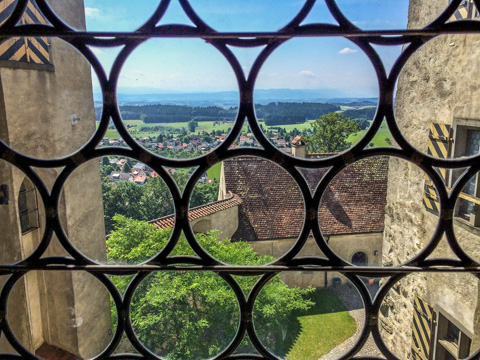
The castle courtyard and views over the countryside from the passage connecting the central keep to the chapel at Waldburg Castle.
In one room of Waldburg castle is a reproduction of the Waldburg-Wolfegg family's most famous cartographic relic, the only known surviving copy of the Waldseemüller Map.
Martin Waldseemüller painted this Universalis Cosmographia in 1507. It ranks as the first true World Map, showing part of the Pacific Ocean lying beyond the New World.
This, confirmed by the accompanying text by Matthias Ringmann, proves Waldseemüller's prescient suspicion that, based on the accounts of an Italian explorer named Vespucci, these lands could not be the outlying islands of Asia many at the time (including Columbus) believed them to be but were, in fact, an entirely new landmass west of Europe and east of Asia.
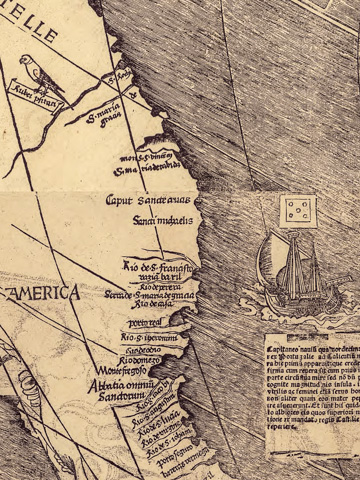
The word "America" (and a jaunty parrot) applied to the New World on this detail from the famous Waldseemüller Map.
Inspired by the descriptions of this New World in the recently published journals of that Tuscan sea captain called Amerigo Vespucci, Waldseemüller decided to label the largest landmass of this vast, unknown new continent with the classical, Latin spelling of Vespucci's first name: America. (He also put a jaunty little parrot on there.)
Point of fact: This means that America was actually named after a travel writer. Just sayin.'
Second point of fact: That "AMERICA" text actually appears over what we now know to be South America, so—proud as we Norteamericanos are to be "American"—that name was applied to lands north of the border more as an afterthought.
(On the Waldseemüller Map, the northern New World landmass—beyond the oversized Caribbean islands—is labelled "Parias"—though even that is on top of what is now Mexico. Most of the future U.S.A. is labeled "Terra Ulteri Incognita.")
Though later, updated versions of the Waldseemüller map existed, all 1,000 original printings of it—in its original, unaltered state—were long thought to have been lost to the ages.
Then, in 1901, a Jesuit scholar stumbled across a lone surviving original that had sat undisturbed for 350 years in a private library. That library? It was in the Waldburg-Wolfegg's main seat, Wolfegg Castle over near Ravensburg. (That's the schloss where the prince actually still lives, so it is only open to the public for the occasional concert; Wolfegg.de)
In 2001, the German government arranged for the Waldburg-Wolfegg family to sell this momentous map to the U.S. (for a cool $10 million). Since 2007, it has been on display in the Library of Congress in Washington, DC.
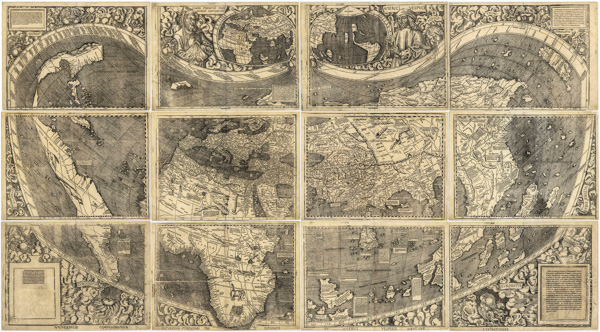
The Waldseemüller map.
Tips & links
Schloss Waldburg
Schloss 1, Waldburg
Tel. +49-(0)7529-911-120
Gemeinde-waldburg.de
Apr-Oct Tues-Sun 10am–5pm
Adm
Give it an hour, maybe another hour to stroll the lovely paths in the surrounding fields and woods.
- Regional tourist info:
- Oberschwaben-tourismus.de
- Bodensee.eu
- Konstanz-tourismus.de
- Tourismus.ulm.de
- Baden-Württemberg tourist info:
- Tourism-bw.com
- Germany.travel
- Stuttgart-tourist.de
- Blackforest-tourism.com
- Heidelberg-tourismus.de
- Baden-baden.com
- Activities & tours:
- Viator.com
- ContextTravel.com
- Intrepidtravel.com
- Gadventures.com
- Infohub.com
- City-Discovery.com
- Localguiding.com
TRANSPORT
- Airfares:
- Momondo.com
- AutoEurope.com
- Vayama.com
- CheapOair.com
- Cheapflights.com
- DoHop.com
- CheapTickets.com
- Priceline.com
- Airports:
- Stuttgart-airport.com, Fly-away.de (Lake Constance); Other airports within 200km: Frankfurt-airport.com, Euroairport.com (Basel), Munich-Airport.com, Zurich-airport.com
- Car/RV rentals:
- Autoeurope.com
- Momondo.com
- RentalCars.com
- CheapOair.com
- AutoSlash.com
- Trains:
- Bahn.de
- Raileurope.com
- Seat61.com
- Apartments & villas:
- Vrbo.com
- Booking.com
- Venere.com
- Rentalo.com
- Homeaway.com
- Belvilla.com
- Interhomeusa.com
- Airbnb.com
- Villasintl.com
- Craigslist.org
- Hostels & campgrounds:
- Hostelworld.com
- Gomio.com
- Hostelbookers.com
- HostelsClub.com
- Hostelz.com
- Booking.com
- Venere.com
- Agriturismo (farm stays):
- Landtourismus.de
- Bauernhofurlaub.de
- Booking.com
Related Articles |
|
This article was by Reid Bramblett and last updated in July 2014.
All information was accurate at the time.
Copyright © 1998–2013 by Reid Bramblett. Author: Reid Bramblett.
Schloss Waldburg
Schloss 1, Waldburg
Tel. +49-(0)7529-911-120
Gemeinde-waldburg.de
Apr-Oct Tues-Sun 10am–5pm
Adm
